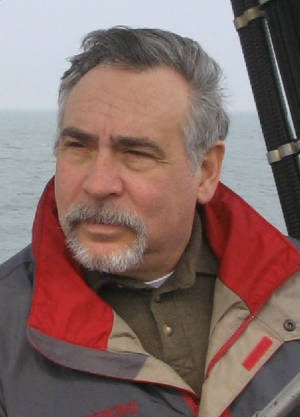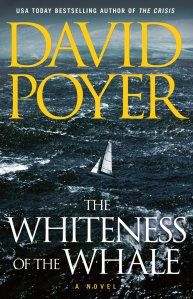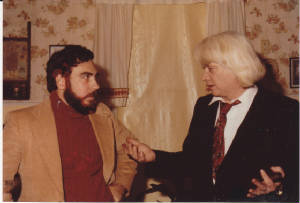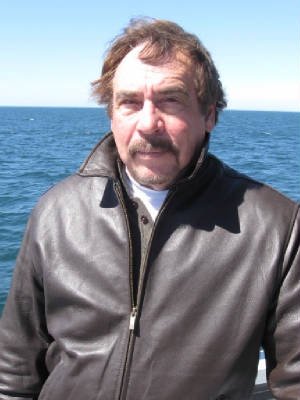|

|
| David Poyer |
David
Poyer’s thirty-year sea career included service in the Atlantic, Mediterranean,
Arctic, Caribbean, Pacific, and the Mideast.
He’s published numerous sea novels with Macmillan/St. Martin’s and three
with Simon & Schuster, as well as sailing and nautical articles for Chesapeake
Bay Magazine, Southern Boating, Shipmate, and Tidewater Virginian. His
work’s been required reading in the
Literature of the Sea course at the U.S. Naval Academy at Annapolis, along with
that of Joseph Conrad and Herman Melville.
He lives on the Eastern Shore with Lenore Hart and their daughter, with
whom he explores the Bay and Atlantic coast in their sloop, Water Spirit.
Zinta for The Smoking
Poet: Welcome to The Smoking Poet,
David. We are honored to have you join us here and tell our readers about your
newest novel, The Whiteness of the Whale.
And it’s your 34th! For those who
have not yet had a chance to read
this book (see our review on the Zinta Reviews page), please give us a synopsis
of its storyline.
David Poyer: Thanks
Zinta! THE WHITENESS OF THE WHALE – the
title is from one of Melville’s chapter titles in MOBY DICK – begins with the
sailing of a group of young activists from Argentina in a state-of-the-art racing
sailboat. Their goal is to stop illegal
Japanese whaling in the Antarctic sanctuary. But, obviously, things don’t turn
out the way they expect.
TSP: Can you talk
to us about the connection between your naval service and the writing of this
novel—as well as other novels you’ve written?
David: I guess
the biggest influence on this book was my service in the Arctic, which took
place in the early seventies. USS Bowen was
ordered to go north of Iceland in the winter, find the biggest storm around,
and stay in it as long as we could. (This was to test a new type of sonar gear
under the most adverse conditions.) I remember Arctic seas, and fogs, and the distinctly
daunting feeling of being out there all alone, hundreds of miles from any possible
rescue. My Navy novels are of course
more closely based on my actual experiences, whereas WHITENESS is more of a
sailing book, or perhaps an ecological meditation. But the polar experience
definitely came In handy.

TSP: How has your
work been received in the naval world? In an earlier interview, you’ve mentioned
actual antipathy against in-service writers. Does that still hold true, and
why?
David: Actually
there was a bit of pushback.
Historically, writers don’t pull a lot of weight in military circles. They’re
perceived as lightweights, if not non-team-players, especially if they argue
against any policy or party lines. But
my feeling is that the Navy is the most forgiving service in that regard; we
see many cultures, so we’re more cosmopolitan, if you will. Or at least that’s
been my impression. Also, in my case, I
was very careful to keep my writing and navy careers well separated. I avoided
official writing assignments, and
always steered clear of the kinds of compartmented intelligence billets that
would subject me to official review of any outside writing. I don’t think
writing hurt me, and in some ways it may have raised my visibility. But of
course, the records of promotion boards are sealed!
TSP: Talk to us
about the connection between Herman Melville’s Moby Dick and The Whiteness
of the Whale, David. We see a reappearance of the motivated whale in your Antarctic
adventure story, a whale with a mission.
David: Motivated
. . . LOL! For me, as perhaps for Melville, in a different way, the whale was a
way to explore how human beings attach very different meanings to material
objects or living beings (such as bats, or snakes, or whales) that the animal
may or may not have any real relationship to. We see that in the different
approaches the crew of Black Anemone
take to the whale one of them nicknames “Cappucino.” The cinematographer
sees it as wounded, in
need of help; the Iraq veteran sees it as an enemy; the Shinto priest’s son
sees it as supernatural, to be placated; the actress sees it as a backdrop to
herself; the environmental activist sees it as justifiably enraged by Man’s
predation on its species; Dr Sara Pritchard sees it as a rogue with a possibly damaged
brain. These viewpoints collide and evolve in the course of the story. At
certain points, I rendered homage to MOBY DICK, and those points will be
evident to the informed reader, but I think the story stands on its own as well. On
level one: an adventure story. Level two:
a retelling of a classic, in modern dress. Level three: a meditation on human
impact on the last unspoiled environment on earth. Level four: an
epistemological investigation. And so
on . . .
TSP: Have you
ever experienced something like this in your own days at sea?
David: A couple
of too-close encounters with sharks.
Nothing with whales!
TSP: There are
some heartrending scenes in this story about the killing of whales. Is it your
intent to raise awareness about the fate of whales? Perhaps also point out some
failings on the part of the activists?

|
| David Poyer and John Gardner |
David: Both, I hope. One notable difference is how
the mindset has changed since Melville’s time. Then, whaling was a noble
industry that gave light to the world. Now it’s an illegal slaughter, on a par
with poaching gorillas or killing elephants for their ivory. But you’re
right, I don’t see the activists
as stainless crusaders, either. Both the whalers and their adversaries are
human. In both the good sense, and the bad. And that, in the end, is what I
think drives the story.
TSP: You’ve said
that you knew from very early on in life that you wanted to be a writer. How
did that come to be?
David: I got the “call” around age four or five,
when my mother told me, while reading to me on the back porch, where books came
from. “Writers write them,” she said. At that moment, I “remembered” what I was
here for. But I had to build up some life experience first. Hence the Naval
Academy, the Navy, and then at last, in my late twenties, setting out to write.
TSP: Do you think
it’s important for a literary work to also carry within it social commentary?
Is that a necessity for you?
David: One of my
early mentors was John Gardner, of NICKEL MOUNTAIN and GRENDEL fame. In fact,
we both wrote books from the same bar conversation in Danville – he, MIKKELSONS
GHOSTS, and I, WINTER IN THE HEART. He
was my ideal of a socially engaged, morally centered writer. And yes, many of
my works have taken positions. Especially the Hemlock County books, but others,
too. DOWN TO A SUNLESS SEA, about water
rights. THUNDER ON THE MOUNTAIN, about
the labor struggles of the 1930’s. GHOSTING, about the consequences of willful
ignorance. The Navy books treat subjects like females and gays in military
service, the enlisted vs. officer dichotomy, and the ever-present choice
between the “right” act and the “expected” act. I don’t pretend to have definitive
answers, and I certainly don’t think every literary work has to treat a
serious subject.
Far from it! STEPFATHER BANK is
just a mad romp, with no theme or moral I’ve ever been able to locate. But if
novelists don’t raise these questions, at least now and then, who will?
TSP: Not many
writers take on the challenge of writing from the perspective of the opposite
gender (and even fewer do so successfully), but you did so in this novel with
your protagonist, Dr. Sara Pollard. What challenges did that present and why
did you choose to write cross-gender?
David: Why, thank
you! But I don’t really think of women as an opposite gender. Less of
certain tendencies and a bit more of
others . . . but not “opposite.” I’ve
often written from the point of view of women, but this was my first book where
the central omniscience, if you will, was female. I try to do something different
with each project,
just to keep things interesting, and it was time to try a female central
character. The effect was unexpected;
after about a hundred pages, I found myself thinking and perceiving the world
differently. As a woman does? Hard
to be sure; but I gradually saw through
her eyes a world of webbed relationships,
rather than the universe of objects and actions I customarily perceive. But at
the same time, as a scientist, she was hard-nosed and analytical when it came
to her specialty – animal behavior. All
in all, it was a revealing experience.

|
| Nantucket in 2013 |
TSP: There’s a
fascinating crew aboard your ship. We’d love to hear something about how you
came up with this crew of characters.
David: Well, Sara
is the descendant of the real-life Nantucket whaling captain after whom Ahab
was modeled. And Edwige Auer is my very twisted take on Queequeg. Tehiyah Doree
(literal translation of her
name: “gilded desert”) is the kind of woman everyone loves to hate. Dru
Perrault is me, with a Quebecois accent. My daughter Naia helped me with Hy
Kimura. And “Captain Crunch” is modeled, and even named, after the Japanese
destroyer commodore in Ned Beach’s RUN SILENT, RUN DEEP. (Beach was another
friend and model.) The others reported for duty as needed!
By the
way, the video trailer – viewable at WHALE video trailer – is pretty impressive. It was put together by a student group led by Laurie
Powers. I can’t believe she filmed it in Louisiana!
TSP: Can you tell
our readers something about your writing process? You are obviously extremely
prolific. How do you not lose steam? Who is your “first eyes” on the first
draft?
David: I teach writing at the Wilkes University
Creative Writing program, and there, I’m considered the “structure” guy . . .
in that I believe in thorough planning before putting fingers to keyboard. I
myself call it the architectural approach.
You don’t send a building crew to put up a skyscraper before you have a solid,
checked, .very detailed plan. At the same time, writers have to be open to
those “gifts” we get from our unconscious. Knowing where I “think” the story is
going forces me to be even more alert to those inspirations. It’s a step by
step process, from character sketches, to character matrices, to scene outline,
to detailed outline, to first draft. And
no one but me gets to see the first draft!
Only at the second draft stage does Lenore Hart, significant other and
fellow novelist – ORDINARY SPRINGS, BECKY, THE RAVEN’S BRIDE -- get to see it.
She’s my first reader, and a very good editor and sounding board, too.
TSP: Thank you so
much for the insights you’ve given our readers into The Whiteness of the Whale,
David. It is truly a thriller, and one
that haunts one even after the reading with thoughts about these incredible
mammals, whales. Perhaps we are not so very much the superior life form …
David: Thank you, Zinta! Superior
life form? The longer I spend on
this planet, the less certain I am of that. Certainly, if only to preserve
ourselves, we have to pay far more attention to the other species who share it
with us. Glad you liked it . . . and I’ll try to do even better next time.
Watch for THE CRUISER next year!
|

